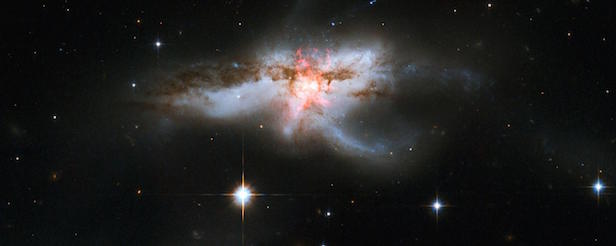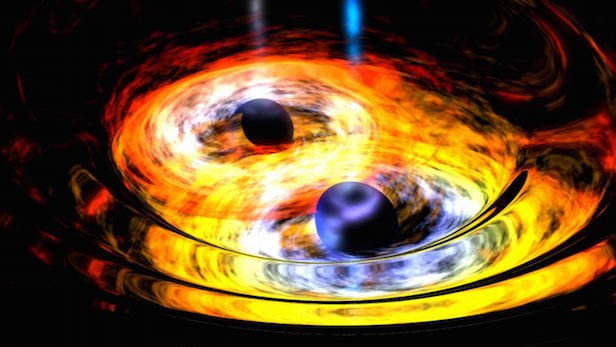Merging galaxies halt star formation
Analysis of the ‘butterfly’ galaxy NGC 6240 shows black hole ejections and stellar winds stop the birth of new stars

NGC 6240 was observed by not only the Hubble Space telescope, but also the VLT and Apache Point Observatory. Image credit: NASA/ESA/Hubble Heritage (STScl/AURA)/A. Evans
The ‘dissection’ of two galaxies in the latter stages of merging has revealed how its two central supermassive black holes are hindering star formation throughout the whole galaxy. It also appears that the black holes are responsible for the galaxy’s unusual ‘butterfly’ shape.
A study by researchers at the University of Colorado Boulder (CU Boulder), led by Francisco Müller-Sánchez, examined the galaxy NGC 6240. What makes this galaxy different to other galaxies is that while most galaxies host just one supermassive black hole, NGC 6240 contains two. These two supermassive black holes appear to be orbiting each other, and this will lead to an inevitable collision and merger. This is a prime indicator that the galaxy is the result of a merger, and is in its final stages of merging.
The results show that the gases ejected by those black holes, partnered with the gas ejected by stars within the galaxy, may reduce the rate of star formation in NGC 6240. It also appears that these ‘winds’ sculpted the massive cloud of gas which make NGC 6240 resemble a butterfly in flight.
“We dissected the butterfly,” says Müller-Sánchez of CU Boulder’s Department of Astrophysical and Planetary Sciences (APS). “This is the first galaxy in which we can see both the wind from the two supermassive black holes and the outflow of low ionisation gas from star formation at the same time.”
Having two well-fed and well-illuminated supermassive black holes, also known as Active Galactic Nuclei (AGNs), in the same galaxy is a very rare scenario. This is why researchers have gravitated towards studying this peculiar galaxy, as it provides a unique look at an important stage in galaxies’ evolutions, much like our Milky Way.
There are other aspects to NGC 6240’s unusual nature however, as it also exhibits bubbles and jets of gas firing in all directions, extending roughly 30,000 light years into the cosmos. This is what gives it its unique butterfly shape – very different from the Milky Way, which forms a relatively neat disk. “Galaxies with a single AGN never show such a phenomenal structure,” says Müller-Sánchez.

The merger of two galaxies has led to two supermassive black holes orbiting one another in NGC 6240. Image credit: NASA
The team at CU Boulder pointed three different telescopes at the suspect: the Hubble Space Telescope, the Very Large Telescope (VLT) in Chile and Apache Point Observatory in New Mexico, United States used their impressive resolving powers to see what is occurring inside the galaxy.
The results showed that two different forces have given the galaxy its butterfly shape. For example in the northwest corner, the winds that originate from stars and transport gas along its path, also known as stellar winds, mould that corner. On the other hand, the northeast corner is dominated by a single cone of gas that originates from the pair of black holes. This cone is a result of the black holes consuming large amounts of galactic dust and gas during their merger.
“The data from these three telescopes allowed us to determine the location and velocity of different types of gas in the galaxy,” says Rebecca Nevin, a graduate student in APS. “This helped us uncover two winds; one that is driven by dual supermassive black holes, and one that is driven by star formation.”
The two winds collectively eject the same mass of about 100 Suns from the galaxy every year. This is a “very large number, comparable to the rate at which the galaxy is creating stars in the nuclear region,” according to Müller-Sánchez.
Such a massive outflow can have harmful repercussions for the galaxy itself. When two galaxies merge, this kick-starts a new era of intense star formation, but this can change when black hole emissions and stellar winds start sweeping away all the material needed to create new stars. It appears there may be ‘negative feedback’ on star formation beginning to occur in NGC 6240.
“NGC 6240 is in a unique phase of its evolution,” says Julie Comerford, an assistant professor in APS. “It is forming stars intensely now, so it needs the extra strong kick of two winds to slow down that star formation and evolve into a less active galaxy.”
Keep up to date with the latest news in All About Space – available every month for just £4.99. Get 5 issues of All About Space for just £5 with our latest offer!





